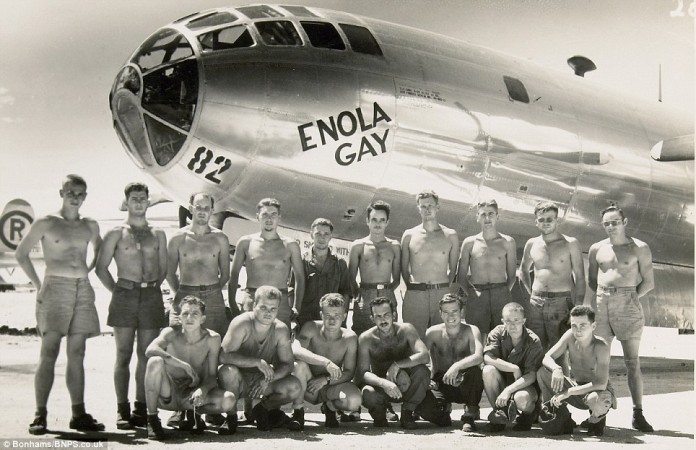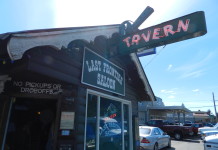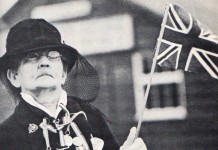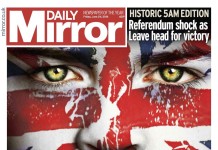
President Obama rightfully pays respects at Hiroshima even as a great American film director slips ever deeper into fiction
By Mark Cromer
The day before President Barack Obama made his historic appearance at a Japanese city that had been literally wiped off the map in August 1945 by a single atomic greeting card dropped from an American airmail express plane christened the Enola Gay, Academy Award-winning director Oliver Stone took to the pages of the Los Angeles Times in an op-ed piece that attempted to put the president’s righteous display of somber acknowledgement (not weepy atonement) into a perspective that much of the American Left hopes will become the standard issue narrative.
According to Stone, America was wrong to drop the Hiroshima bomb and the follow-up knockout punch that fell on Nagasaki three days later. Murderously wrong. And, according to Stone, it was really the Soviets that won the war in Pacific. Not the Americans who actually fought it.
Obama’s appearance at Hiroshima was a trigger mechanism for a “national reckoning” that was long overdue, Stone claimed in the op-ed, bootstrapping history professor Peter Kuznick, PhD, to the column in a double byline apparently for some semblance of intellectual cover. Kuznick’s academic title of Professor of History and Director of the Nuclear Studies Institute at American University, at least adds a certain gravitas at face value.
“Most Americans have been taught that using atomic bombs on Hiroshima and Nagasaki in August 1945 was justified because the bombings ended the war in the Pacific, thereby averting a costly U.S. invasion of Japan,” Stone and Kuznick wrote. “This erroneous contention finds its way into high school history texts still today.”
President Harry S. Truman and the American military brass advising him during the final stages of the titanic global struggle of World War II were just a little too eager to drop ‘The Bomb,’ as Stone sees it, and did so not to end the war more quickly and with ultimately fewer killed, but for purely political and rather overtly racist reasons.
Stone salts the term “Jap” throughout his screed, using the pejorative slang for the Japanese that was once ubiquitous in America at war during the 1940s, quoting Truman’s various use of it in correspondence as the war raged on. “Telegram from the Jap emperor asking for peace,” was one quote from Truman. “He’ll be in the Jap War on August 15. Fini Japs when that comes about,” went another.
Stone’s op-ed reads as if he felt that if he wrote that now derogatory term enough times it would explode in a revelation to the reader as a vile hate crime that underpinned the decision to drop the atomic bombs that finally brought the war to an end. But the historical fact remains that during World War II the American people referred to their enemy in less than kindly terms and the Japanese soldiers that slaughtered more than 70,000 American and Filipino men on the Bataan Death March were known in the popular vernacular as ‘Japs’ and the Germans that rolled over Europe and North Africa in an effort to install their maniacal ‘New Order’ were called ‘Krauts,’ ‘Huns’ and other terms that reflected a national contempt for the enemy.
And while Stone wants to soft-peddle it today for reasons only he understands, Imperial Japan, Nazi Germany and Fascist Italy were the enemy. The enemy. And they were a rabid enemy that knew no bounds of conduct in war, if there really is such a thing, let alone social decency on the pages of their newspapers, newsreels or in polite conversation at the time.
Stone makes the case that by the time the Enola Gay was 31,000 feet over Hiroshima on August 6, 1945, the Japanese were already ready to surrender, and were indeed trying to, if only bloodthirsty America would have let them. Stone’s op-ed describes a defeated Asian nation trying desperately to get America to understand it was crying ‘Uncle’ (Sam), even as the evil round-eyed Anglo-Saxon horde was island-hopping its way across the South Pacific intent not to defeat an existential enemy, but to destroy a people.
But as Stone has it, even as the mightiest naval fleet ever assembled made its way toward Japan for the final act in a slugfest across the Pacific that had started in the late hours of four years earlier, it was the arrival of the Soviet Union in the Pacific theater of war that was the real reason for Japan’s surrender.
“When Prime Minister Kantaro Suzuki was asked on August 10th why Japan needed to surrender so quickly, he explained, ‘the Soviet Union will take not only Manchuria, Korea, Karafuto, but also Hokkaido. This would destroy the foundation of Japan. We must end the war when we can deal with the United States,’” Stone related. “Japanese leaders also feared the spread of Soviet-inspired communist uprisings and knew the Soviets would not look kindly upon their paramount concerns — protecting the emperor himself and preserving the emperor system.”
And so in one fell swoop did Stone erase the more than 110,000 American soldiers who had died fighting through the jungles across the South Pacific over four years on their way to Japan, along with the more than 250,000 G.I.’s that were grievously wounded. To say nothing of the 4 million Chinese that died fighting Japan during World War II, or of the Australians, Filipinos and other Allied forces. The Soviets entered the war against Japan on August 9th, the day America served its second scoop of atomic ice scream to Tojo & Co. as a cherry on top to the Hiroshima sundae it dished up only three days earlier. Historically speaking, it’s hard to say now who shit more at the sight of the mushroom cloud over Hiroshima, Stalin or Hirohito. The Soviets saw the writing on the post-war wall and rushed into the fray while there was still some geopolitical card to be played, as short-lived as it was. To be clear, the Russians did indeed muster more than a million troops for its push into Japanese-occupied Manchuria, and the Soviet’s entry into the Pacific theater was another sign to Tokyo that The End was only a matter of time, not a question.
But in his op-ed in the Los Angeles Times, Stone remodels history in suggesting that Russia’s understandably late play in the Pacific was the game changer.
There’s no question that the Soviet’s blood-soaked resistance against the Wehrmacht’s invasion of Russia in the summer of 1941, in which Nazi Germany threw more than 4 million men across the Motherland’s tragically unprepared frontier, and then the Red Army’s epic come-from-behind victory in the east led to the Allied triumph in Europe.
But Stone’s proclamation that the Soviet’s were effectively the spear-point of ‘VJ Day’ is a perverse insult.
And it’s a historic whitewash, to put it in terms he might appreciate.
It’s unclear just how much actual input Dr. Kuznick was given in Stone’s op-ed or whether he was just paid a fee for the use of his name and a copyedit (were Stone not the author, it would never have been published in the newspaper), but the claim that the Japanese were preparing to surrender—indeed, pleading to surrender—in the late summer of 1945 is absolute fiction. While Stone spouts nonsense about the Soviets “quickly routing” Japan’s Kwantung Army as the blow that brought Tokyo to its knees, the historical record paints a starkly different picture.
In August 1945, Japan was prepared for the Alamo-like final stand for its homeland.
As America and her allies mustered their fleets and invasion forces for Operation Downfall, expected to take place by November 1945, Japan was preparing to meet them in a flaming house of the rising sun. Japan had gathered for the defense of its homeland more than a million troops ready to confront the allied forces in the initial landings and more than 3,000 aircraft—most Kamikaze—to rain suicidal death on the American invasion fleet. In the water, it was planning to drive the shattered remains of its surface fleet into a similar death ride. While Japan had no hope of defeating the invasion during the landings, its intent was to inflict a devastating enough price for them that the Americans would negotiate a peace rather than face the remaining 3 million Japanese soldiers that would resist the subjugation of the rest of the country.
Stone made no mention of two epic battles that had unfolded in the Pacific just months earlier—Iwo Jima and Okinawa—that had given Washington a whiff of what was to come with the invasion of Japan. In early 1945, the Marines waged one of the bloodiest battles in its two century-plus history on the black sands of Iwo Jima, losing nearly 7,000 men with another 20,000 wounded in a gory slugfest fought out across the volcanic ashen landscape where Japanese defenders popped out of dung holes everywhere as America’s grunts fought their way to raise the Stars & Stripes victoriously on Mount Suribachi. After Iwo Jima was over, the Marines landed on Okinawa in April 1945 and waged a nearly three month battle for another Japanese island that killed more than 20,000 Americans and wounded more than 55,000 more. In return, they put more than 100,000 Japanese soldiers in their graves. It’s worth noting to anybody apparently but Stone that the Americans captured less than 7,000 Japanese soldiers in a horrifying three-month battle that didn’t end unti late June 1945. Seven percent of Japanese soldiers were taken prisoner. The rest preferred death.
Iwo Jima and Okinawa were outlying islands that American young men had to fight through in 1945, which hellish as they were to take were not the home island of Japan. This is not just simple geography, this is important, as the death toll attests. The closer the Americans came to the home island of Japan, the bloodier the battles became.
Stone’s argument as laid forth in the Los Angeles Times was that Japan was more than prepared to surrender when America was finally knocking at its door.
But that’s not true, as Stone surely knows.
The Japanese were under no illusion as to the war’s outcome by the summer of 1945, but they intended to go down fighting just as their German allies had, which bears a consideration that Stone and his tag along Kuznick declined to give it, but one that is worth noting.
In early June 1944, the Allies landed in Normandy and as they fought their way through the vicious German defense of occupied France in the west, the Soviets launched Operation Bagration in the east, smashing the most powerful German mechanized armies in the field, with more than 600,000 men and 1,000 panzers in Army Group Center alone, which bore the brunt of the Soviet offensive and was crushed under the Red Army’s vengeful mass tide. The German nightmare of a two front war had turned into a three-front slow death as the Allies converged from the east and west as well as slugging their way up the Italian peninsula.
As 1944 came to a close, the Americans in the west were converging on the Rhine while the Russians in the east had closed in upon the Vistula, and as such Adolf Hitler’s Third Reich found itself in a fatal vice of its own making. By that fall of 1944 the German General Staff had considered the war effectively over. Its industrial heartland in the Ruhr and Silesia had been blown to smithereens by American and British air raids that saw as many as 1,000 bombers a day paying a visit. Entire German cities like Hamburg, Frankfurt and Dresden were literally blown off the map, along with the virtual leveling of Berlin.
As early as July 1943 the Allied air campaign of strategic bombing was wrecking havoc on the Germans before their Japanese allies were feeling the same pain. “During the night we had the heaviest raid yet made on Hamburg,” the chief Nazi propagandist Josef Goebbels wrote in his diary on July 29, 1943. “With 800 to 1,000 bombers…a city of a million inhabitants has been destroyed in a manner unparalleled in history. We are faced with problems that are almost impossible of solution…some 800,000 homeless people who are wandering up and down the streets not knowing what to do.”
And that was the summer of 1943. By the fall of 1944, the complexion of the war in Europe had grown dramatically darker for Goebbels and his fellow Nazis. As Field Marshal Karl von Runstedt noted later under Allied interrogation: “As far as I was concerned, the war was over in September.”
Except it wasn’t.
The Germans not only fought on, but launched a series of mad-men offensives on both eastern and western fronts, killing tens of thousands of Allied troops amid their Götterdämmerung into the spring of 1945, when America and Russia finally turned off Germany’s lights and started the war crimes trials in Nuremberg where Nazi war criminals were tried and hung.
Which brings us back to Oliver Stone.
As President Obama made his way to Hiroshima to pay proper respects for all the victims of a terrible war and in doing so reminded the planet of what is at stake, Stone took to the pages of the Los Angeles Times to declare that America dropped not one but two atomic bombs on Japan not because the military situation required it, but for no other reason than it wanted to test the atom bomb on some peoples of color and flex its new muscle in the Soviet’s face at the same time.
Stone’s take on history has been controversial in the past, with perhaps none so more than his epic cinematic masterwork JFK, but the difference between his meticulously researched and factually-based 1991 film, which Stone dubbed a “counter myth to the Warren Report,” and his assertions that Truman had needlessly nuked the Japanese in August 1945 is as vast as the South Pacific.
Without the terrible twin atomic bombings of Hiroshima and Nagasaki, the Japanese could have and most surely would have fought on well into 1947 or even later, inflicting a million or more American causalities as well as resulting in perhaps tens of millions of more Japanese dead and wounded as a ground war rolled into its cities.
Stone claims that Truman’s decision to drop ‘The Bomb’ was not a last resort.
It’s hard to imagine what a last resort would have to look like if the lives of a million American soldiers don’t suffice. But fortunately, Truman was there to make the call, and Stone only gets to recast it in a fantastical if gross Hollywood makeover.










